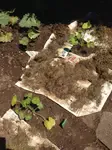Slugs
Slugs and snails are a common problem especially if you live in a moist climate or if your garden is in a moist and shady location. Spring is the time where they start creating havoc in the vegetable plants as the moisture and new plant growth attracts them. They are most active at dusk and have a tendency to hide out during the heat of the sun.
Adults are worm like, soft bodied animals; they have no shell whereas snails have a coiled shell. They can measure 1/8 inch up to 3 inches. They can be black, greenish yellow or grey in colour. They leave a trail of mucus on the ground and on the plant.
Almost any young transplant or new sprouted seeds can be affected. The most common vegetables affected in my vegetable garden are lettuces, spinach, beans, peas, and brassicas.
How to identify them.
Do you have a problem with this pest?
- They eat leaves, chewing large holes in the leaves and stems.
- There is shiny slime or mucus trail on the foliage or in the soil.
- You can find tiny grey ones in the base of your mature lettuce plants so check them once harvested.
What to do about slugs:
For me the best way to control this pest is to take the time to walk through the garden at dawn or dusk and kill them. I use the edge of my shovel chopping them in half, or you can pick them up and place them in salt water so they drown.
Placing some beer in a dish will attract them and they drown themselves in it.
You can also leave out pieces of wood during the day and they will hide under it for shade. Turn the piece of wood over and then destroy them.
Moving them to another area will not work as they can travel a great distance in one day. If you have a problem with this pest it is important to take the time to destroy them as they can damage your whole garden bed in a matter of a few nights.
A lot of people can be squeamish about touching these pests but it is important to keep them out of your vegetable patch especially in the spring in order to give the young plants a healthy start.
Return from Slugs to Garden Pest Control
Return to homepage
Recent Articles
-
Organic Gardening soil amendments - List of material?
Aug 09, 25 10:57 AM
What materials are best used as organic gardening soil amendments? -
Tips for disease control in your vegetable garden
Jul 14, 25 11:15 AM
Easy tips for disease control to keep your vegetable growing its best. -
Joy of vegetable Gardening
Jul 14, 25 11:01 AM
Everything you need to know is right here to have Joy of Vegetable Gardening





